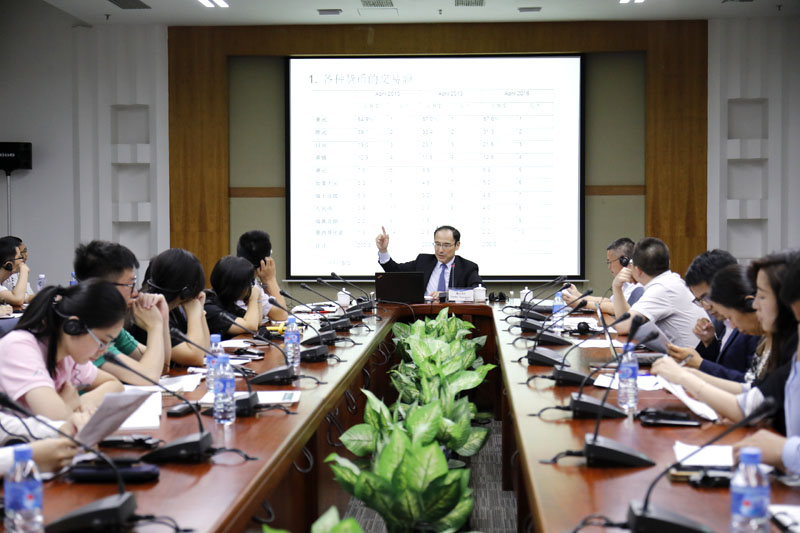Information
 CDI invited Professor Yosuke Tsuyuguchi from the College of Economics, Nihon University to share the experience of Yen’s internationalization, including the gains and losses in the internationalization process and how the process is relevant to RMB internationalization.
CDI invited Professor Yosuke Tsuyuguchi from the College of Economics, Nihon University to share the experience of Yen’s internationalization, including the gains and losses in the internationalization process and how the process is relevant to RMB internationalization.
Date: August 25, 2017
Venue: Room 101, CDI Mansion, Shenzhen
Host: CDI
Theme: Rethinking RMB Internationalization: Why is Japan so Prudent about Yen’s Internationalization?
Program
Program
14:30-14:35 Opening Remarks
GUO Wanda, Executive Vice President, CDI
14:35-15:35 Dialogue: Rethinking RMB Internationalization: Why is Japan so Prudent about Yen's Internationalization?
Yosuke TSUYUGUCHI, Professor, College of Economics, Nihon University
15:35-16:25 Q&A
16:25-16:30 Closing Remarks
Highlights
Highlights
RMB can learn the experience of the internationalization of the Japanese Yen, which is the third largest currency globally. Closely related to domestic and international economic landscape, each stage of Yen’s internationalization shows distinct features. Since the setback in Yen’s internationalization process in the 1980s and 1990s, efforts have been made to improve the domestic financial market, enhance cooperation with other regions in Asia and increase Yen use in the region, leading to the next breakthrough in the international process of the currency.
From the transaction volume of global currencies and the proportion in global foreign exchange reserve, the Yen is a third-ranking international currency. In terms of the transaction volume in 2016, the U.S. dollar, the Euro and the Japanese Yen are still the top three international currencies, with a market share of 87.6%, 31.3% and 21.6% respectively. The RMB ranks 8th with a market share of 4.0%. The statistics issued by the IMF in March, 2017 shows that the top three international currencies are still the U.S. dollars (5709 billion dollars, accounting for 64.5%), the Euro (1706 billion dollars, accounting for 19.3%) and the Yen (403 billion dollars, accounting for 4.6%) . The RMB ranks 7th with 88 billion U.S. dollars, accounting for 1.0 %. In the above two rankings, the status of the Japanese Yen is increasingly established with significant advantages, ranking the 3rd in a considerably long period, but with rather low use rate in international trade.
Process of the Yen’s internationalization
The rapid development of Japan’s economy in the 1970s and the opening of the financial market provided an opportunity for the Japanese Yen to go international. In 1984, Japan’s Ministry of Finance issued an announcement titled “The Current Status and Prospect of Financial Liberalization and Japanese Yen’s Internationalization”, achieving the full liberalization of the capital account and officially starting the process of Yen’s internationalization. Despite a series of measures to promote Yen’s internationalization, the scale of use in international trade in goods and financial transactions still fell far short of the expectations of the Japanese government.
The setbacks in interest rate liberalization and economic bubbles have affected the progress of Yen’s internationalization. In retrospect, Japan revised the law on foreign exchange management in 1980, and abolished the limit on trade between the Yen and foreign exchange in 1984, thus introducing the freely floating exchange rate regime and liberalizing the transaction of capital account items, but the reform on interest rate failed. Meanwhile, “window guidance” still applied by Japan’s central bank has had a negative impact on the effectiveness of Japan’s monetary policies, resulting in a huge influx of capital into Japan, which became an important trigger for the country’s economic bubbles. The occurrence of the bubble economy and its final burst severely disrupted the financial market of Japan and also hindered the internationalization of the Yen.
The low interest rate and low foreign exchange rate policy has weakened the Yen’s appeal for investors, putting its internationalization under huge pressure. Following the burst of the bubbles, Japan’s central bank switched from the previous monetary tightening to a slash of interest rate to recover the economy and boost domestic demand. Between 1991 and 1995, the central bank downwardly adjusted the benchmark discount rate for a total of 9 times, and the interest rate of the Yen has been at relative lows throughout the “lost two decades”. Meanwhile, with the turbulence in financial market in the wake of the Asian financial crisis and the substantial devaluation of the Yen, the value of the Japanese Yen against the U.S. dollar was in a long-time doldrums. Against these dual backdrops, foreigners were lukewarm about investing in Yen. The internationalization of Yen slowed down again due to insufficient demand from the external market.
Experience from the Yen’s internationalization
The experience of Yen’s internationalization shows that a currency’s internationalization process and domestic financial system are complementary to each other. In particular, the integrity of domestic financial system and whether the market is liberalized enough to meet the needs of internationalization will have huge impact on the internationalization process. Therefore, the internationalization of the RMB shall be steadily promoted while firmly situated in the context of Chinese financial market realities.
First, it is essential to properly measure financial liberalization reform. The setbacks experienced by the Japanese Yen in internationalization shows that the optimal time sequence is to first liberalize interest rate and foreign exchange rate, and adjust domestic monetary policies, before opening up the capital market. In promoting the internationalization of the RMB, it would be highly risky to speed up the opening and liberalization of the capital account without supporting reforms. Before achieving full development of China’s financial market, it might be impossible for offshore operations to avoid risks and shocks, which will threaten the stability of the domestic financial market. The precondition for an open and liberal capital account is therefore free exchange rate and interest rate with timely adjustments of monetary policies.
Secondly, the opening of the financial market shall be dynamic while maintaining stability. The marketization of interest rate in Japan is a slow and gradual process, during which period Japan’s financial market has maintained overall stability. From this sense, the “window guidance” policy by the Japanese government is not without merits. However, being overly focused on the stability of financial market at the expense of the reform would increase the vulnerability of Japan’s financial system, which became all the more evident with the emergence of non-performing loans following the burst of bubbles. Therefore, China must approach financial stability with a holistic view, promoting financial reform at a measured pace while adjusting monetary policies to create favorable conditions for the internationalization of the RMB.
Regional economic cooperation to bolster the internationalization of a currency
Since the 2008 financial crisis, Japan gradually stepped up its economic and financial cooperation with other Asian countries in a bid to facilitate the internationalization of the Yen by promoting its use regionally. Such experience is also of reference value for China in promoting RMB internationalization.
The integration into regional economic and financial cooperation is conducive to enhancing the competitiveness of the local currency. It has become a consensus between China and Japan to reduce dependence on the U.S. dollar and the use of it since the outbreak of the financial crisis in 2008, with the cooperation on currency becoming a new area where financial interests converge. In June 2012, direct cross-border trade between the Japanese Yen and the RMB was officially made possible, simultaneously starting the direct trade between the Yen and the RMB in Tokyo and Shanghai. The report on Japan’s foreign exchange issued by Japanese Ministry of Finance mentioned Japan’s willingness to enable direct trade with other Asian countries, as well as a foreign currency settlement system covering the RMB. This came as a new opportunity for China and Japan to cooperate on the internationalization of their respective currencies. It is of great significance to promote currency cooperation between the two countries and across Asia.
Gallery
https://en.cdi.org.cn/component/k2/item/370-cdi-international-report-on-rethinking-on-rmb-internationalization#sigProId2820483b03










